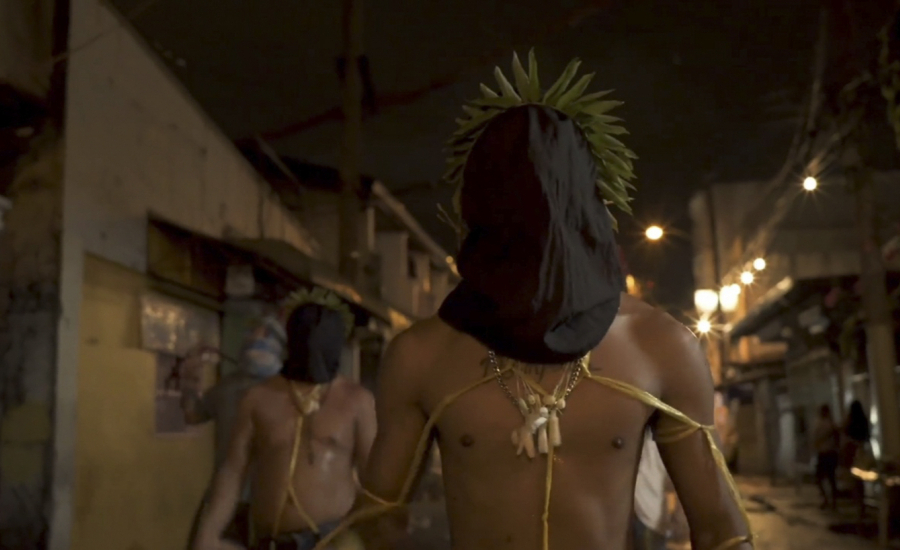11/08/2020
Since the election of Filipino President Rodrigo Duterte, a collection of evil spirits have been appearing on the streets of Manila.
Director: Alyx Ayn Arumpac
Producents: Armi Rae S. Cacanindin, Alyx Ayn Arumpac
Country: Philippines, France, Norway, Qatar, Germany
The aswang, a creature of Filippino folklore, is said to hunt for humans after nightfall. Nobody is sure what it looks like, because it shapeshifts. Some see a werewolf, others a ghoul. In a sense, its form doesn’t matter, because when the warning is voiced from neighbour to neighbour that an aswang is afoot, everyone knows what it means: «Be afraid.» Filippino documentarian Alyx Ayn Arumpac references the beast to atmospheric effect in the opening sequences of Aswang, her debut feature. Talk of the feared figure has risen in recent years in Manila, as the capital’s slums have been transformed into killing fields by populist hardliner President Rodrigo Duterte’s declared war on drugs.
Mystique
The corpses of loved ones and blood literally running in the streets after yet another extrajudicial killing under cover of darkness could not be more real to the slum inhabitants, but the poor’s access to accurate media information and influence over the workings of the top echelons of government is non-existent. Many families blame rogue cops and vigilantes while still pledging their support to Duterte, even when their own relatives have been slain. For any who do suspect his hand, speaking out is dangerous. Whether or not all citizens believe it, it’s safer to make sense of the world through abstract, shadowy folk stories, than admit the possibility that the state is corrupt and cannot be trusted. In associating Duterte with the aswang, the film may be in danger of feeding further into the President’s macho mystique, but the point is astute that his adulation among the people he’s killing can make him seem just as untouchable.
Since Duterte came to power in 2016, he has pursued a campaign promise of stamping out drug users (rather than, crucially, focusing on the drug kingpins at the top of the chain.) While extrajudicial killings by vigilante death squads have been flagged up as systematic in the Philippines by the nation’s Commission on Human Rights, Duterte has denied his direct involvement, while refusing to hold them accountable. Communities are being terrorised in this manner at the rate of around 1,000 deaths per month.
The murders continue
While disappearances have become common, those who return are scarcely listened to if they detail abuses, as people have been conditioned to look the other way, to avoid being next. A parade of men flagellate their own backs in a bloody street spectacle; a ritual to ask the aswang for forgiveness. The murders, of course, continue. Some citizens are indignant and enraged enough to protest against those in power, despite the risks. Footage of the actual president is absent from a documentary that is most concerned with giving a voice and face to those persecuted by the pervasive threat of the drug war and its violence. We do see a huge effigy of him, devil-like, being burnt in the streets at a protest in defense of human rights, a glowing McDonald’s sign in the background as demonstrators chant, among other slogans: «Down with imperialism.» Duterte has ramped up his attacks on the impoverished and drug-dependent even more since American president Donald Trump praised him upon visiting Manila in 2017, detractors of the Filippino leader have said.
Some see a werewolf, others a ghoul.
For much of the film, Arumpac takes us in among Manila’s dark and muggy alleyways, piled with garbage and punctuated by neon, to meet the people bearing the brunt of Duterte’s policies. Poverty is stark, the makeshift warrens that residents call home barely holding together. In a justice system that determines outcomes by wealth, with the rich who are convicted landing in air-conditioned cells while the poor are more likely to simply end up killed, luck is hard to come by for slum-dwellers. A buy-bust operation shows police are very active in their determination and schemes to round up users. Substance fans say that, while fear is inevitable, «this is our vice» — with everyday life so tough, they are unwilling to forsake one of the few activities that grant them temporary pleasure. There is a constant flow of bodies through the morgue, and demand for financially assisted funerals so high it can scarcely be met. One young man’s cadaver has a scar that suggests he may have previously sold an organ; a short life already endured in extremes of desperation. Jomari, a child whose addict mother is in jail, goes missing during the course of filming, and as Arumpac tries to track him down we are kept in suspense as to whether he will have a happier fate.
Shocking even by the standards of the police force’s normalised power abuses and routine fake reports is the discovery by the Commission on Human Rights after a tip-off of a secret cell behind a cabinet at the back of a precinct, in which people kidnapped for ransom are being kept in total darkness and threatened with false drug charges if they do not pay. «It felt like I was buried underneath the ground,» says one of the captives. For Manila’s poorest, dehumanised and stripped of their dignity, life can resemble a walking death sentence.
Review by Carmen Gray, published in MODERN TIMES REVIEW.



